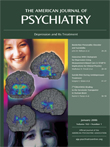Antidepressants in Amniotic Fluid: Another Route of Fetal Exposure
Abstract
OBJECTIVE: The authors’ goal was to determine the concentration of antidepressants in amniotic fluid during maternal treatment of depression. METHOD: Women treated with antidepressants undergoing amniocentesis for obstetrical reasons were enrolled. Antidepressant concentrations in amniotic fluid and maternal serum were determined with high-performance liquid chromatography. RESULTS: Amniotic fluid was obtained from 27 women, and the amniotic fluid’s antidepressant concentrations were highly variable. For the parent compounds, the amniotic fluid concentrations of selective serotonin uptake inhibitors averaged 11.6% (SD=9.9%) of maternal serum concentrations (N=22). Amniotic fluid to maternal serum ratios were higher for venlafaxine: 172% (SD=91%) (N=3). Of interest, the amniotic fluid to maternal serum ratios for the metabolites (N=19) did not demonstrate a consistent pattern compared to the parent compound ratios. In 10 subjects, the amniotic fluid to maternal serum ratio for the metabolites was higher than the parent compound and lower in the remaining nine subjects. CONCLUSIONS: The pattern of antidepressant concentrations in amniotic fluid is similar to recent data for placental passage. Although the significance of amniotic fluid exposure remains to be determined, these results demonstrate that maternally administered antidepressants are accessible to the fetus in a manner not previously appreciated.



